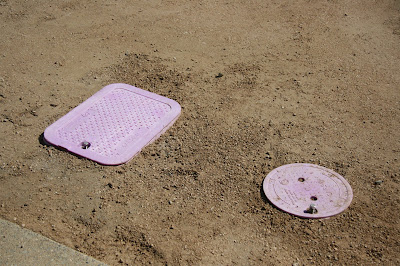The first fig was ready for harvest today! It was the "brown turkey" variety and its skin was a pretty purple color. In the garden I was not sure if the fruit was ready to be picked, but it was soft to the touch, and luckily when we cut into it it was perfectly ripe, juicy and sweet. According to the California Rare Fruit Growers website figs must be allowed to ripen on the tree as they will not ripen if picked when immature, and you will know they are ready when the fruit is soft and begins to bend at the neck. I also found out that fresh figs do not store well; they will only last 2-3 days in the refrigerator, so when you pick them, make sure you are ready to use them right away!
 |
| the first fig of the season |
 |
| the fig was perfectly ripe and very sweet |
If you are lucky enough to have a fig tree in your yard there are tons of great recipes-figs are versatile as they work well in both sweet and savory dishes. Click here to visit the California Fig Advisory website - they have a great recipe book for "Fig Fest 2010" that includes fig and orange beignets, Gary's fig and pecan cinnamon rolls, and causa con salmon with fig compote.
 |
| The brown turkey fig tree is only about 5 feet tall right now |
Here are some other fun fig facts from the California Fig Advisory Board website:
- Figs provide more fiber than any other common fruit or vegetable.
- Although considered a fruit, the fig is actually a flower that is inverted into itself. The fruits are the seeds or "pedicellate drupelets" found inside.
- Figs contain a natural humectant -- a chemical that will extend freshness and moistness in baked products.
- California dried fig production has averaged 28 million pounds over the last five years. All dried figs harvested in the United States are grown in California's Central Valley.










































